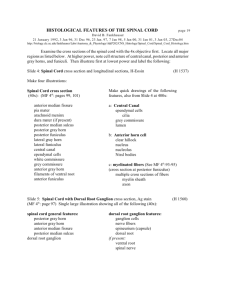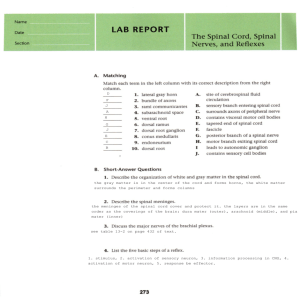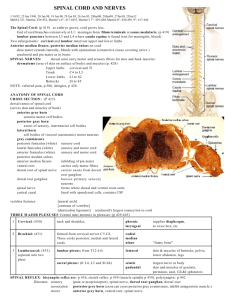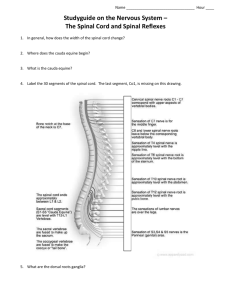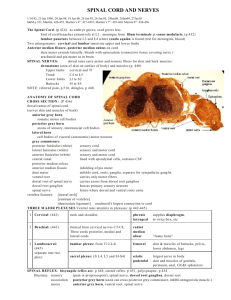SPINAL CORD -1
advertisement
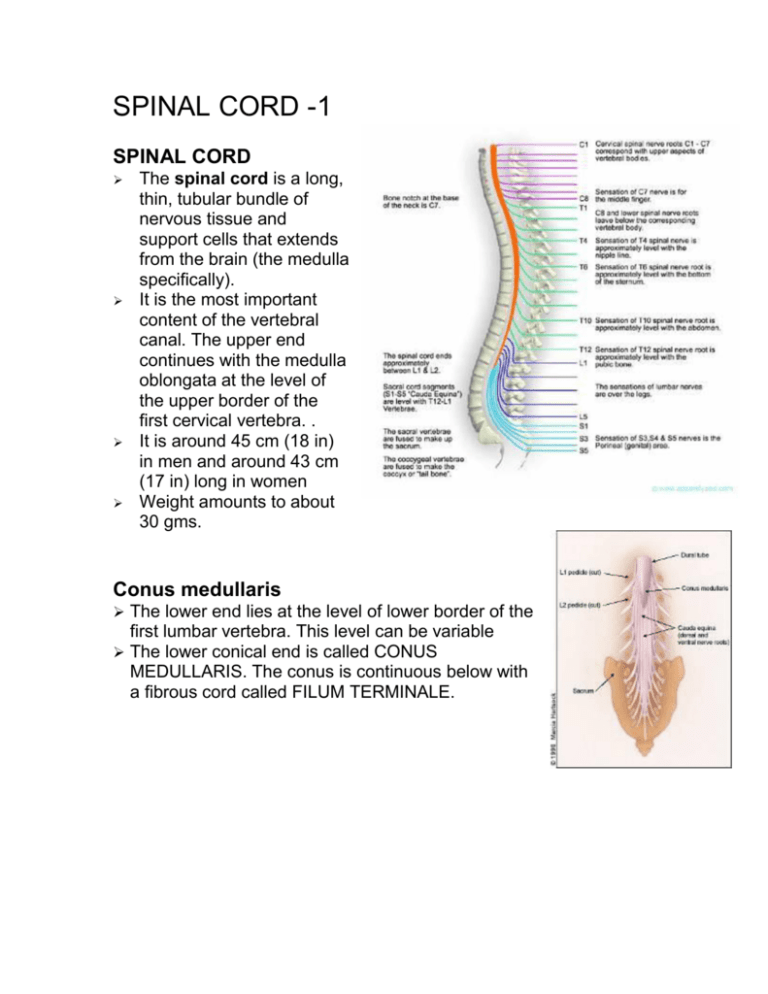
SPINAL CORD -1 SPINAL CORD The spinal cord is a long, thin, tubular bundle of nervous tissue and support cells that extends from the brain (the medulla specifically). It is the most important content of the vertebral canal. The upper end continues with the medulla oblongata at the level of the upper border of the first cervical vertebra. . It is around 45 cm (18 in) in men and around 43 cm (17 in) long in women Weight amounts to about 30 gms. Conus medullaris The lower end lies at the level of lower border of the first lumbar vertebra. This level can be variable The lower conical end is called CONUS MEDULLARIS. The conus is continuous below with a fibrous cord called FILUM TERMINALE. Cervical and lumbosacral enlargement The spinal cord possesses two symmetrical enlargements which occupy the segments of the limb plexuses: cervical enlargement (C3 to T1) for the brachial plexus and the lumbosacral enlargement (L2 to S3) for the lumbar and sacral plexuses. Both enlargements are due to the greatly increased mass of motor cells in the anterior horns of grey matter. Fissures and sulci Anterior Median Fissure A deep midline groove, present on the ventral side It contains a double fold of pia mater Posterior Median Sulcus Dorsally it shows a shallow posterior median sulcus, from which a posterior median septum of neuroglia extends into its substance. Spinal meninges Spinal cord is ensheathed by three protective membranes, separated from each other by two concentric spaces . Dura mater outer most strong, fibrous membrane ends at the level of S2 Arachnoid thin, transparent sheath Pia mater closely invests the spinal cord and sends delicate septa into its substance. Meningeal Spaces Epidural space between vertebral canal and dura mater Subdural space Between the dura mater and the arachnoid contains lymph Subarachnoid space Between arachnoid and pia mater Filled with cerebrospinal fluid Spinal Nerve Roots The anterior and posterior roots of the spinal nerves unite within the intervertebral foramina. Within the subarachnoid space the nerve roots are attached to the spinal cord by a series of rootlets. Each anterior root is formed by three or four rootlets which emerge irregularly along the anteriolateral surface of the spinal cord. Each posterior root is formed by several rootlets, attached vertically to the posterolateral surface of the cord. Posterior root has a spinal ganglion Spinal Nerve Roots The pairs of spinal nerves are grouped as follows: cervical 8 thoracic 12, lumbar 5, sacral 5, coccygeal 1 Upper cervical roots are horizontal Upper thoracic roots slope down at an angle to reach their foramen. Below L1 vertebra the roots pass almost vertically downwards through the subarachnoid space, forming the CAUDA EQUINA. The filum terminale extends down from the tip of conus medullaris among the nerve roots of the cauda. INTERNAL STRUCTURE The spinal cord consists of a central mass of grey matter (cell bodies), in the form of a vertically grooved column surrounding the central canal, enclosed in a cylindrical mass of white matter (fibers). It is divided into two halves by the anterior median fissure and the posterior median septum. The septum extends forwards as far as the grey commissure (the central limb of the H in cross-section) which connects the grey matter of the right and left halves of the cord, and contains the central canal. Grey matter Grey matter contains neural cell bodies, in contrast to white matter, which does not and mostly contains myelinated axon tracts In a transverse section each half of the gray substance is shaped like a comma or crescent, the concavity of which is directed laterally; and these, together with the intervening gray commissure, present the appearance of the letter H. An imaginary coronal plane through the central canal serves to divide each crescent into an anterior or ventral, and a posterior or dorsal column. Anterior horn Anterior horn of the spinal cord (or anterior cornu, or anterior column, or ventral horn) is the ventral (front) grey matter section of the spinal cord The more medial anterior horn cells are concerned with the innervations of trunk musculature, with more lateral cells supplying the limbs Posterior horn Posterior horn (posterior cornu, dorsal horn, spinal dorsal horn) of the spinal cord is the dorsal (more towards the back) grey matter of the spinal cord. It receives several types of sensory information from the body, including , proprioception, and vibration Lateral horn Between the limb enlargements, from segments T1 to L2, there is a small lateral horn, containing preganglionic sympathetic cell bodies. Their axons pass out in the anterior nerve roots and enter the spinal nerves from T1 to L2. A similar group of cells forms the small lateral horn in sacral segments 2-4. The cells of the grey matter in each half of the cord lie in specific functional groups or laminae designated by the Roman numerals I to X. Laminae of grey matter The cells of the grey matter in each half of the cord lie in specific functional groups or laminae designated by the Roman numerals I to X. Among the more important cell groups in the various laminae are those of Lamina II which constitute the gelatinous substance; Lamina V are a main source of anterolateral tract (spinothalamic and spinoreticular) fibers; Lamina VII contains in its medial part the thoracic nucleus and laterally the thoracolumbar(sympathetic) and sacral (parasympathetic) lateral horn cells Other cells of lamina VII, together with those of lamina VIII, are interneurons involved in coordinating motor activity and projecting to lamina IX Lamina IX contains the α and γ motor neurons which innervate skeletal muscle. Central canal Central Canal (canalis centralis) runs throughout the entire length of the medulla spinalis. The portion of gray substance in front of the canal is named the anterior gray commissure that behind it, the posterior gray commissure The central canal is continued upward through the lower part of the medulla oblongata, and opens into the fourth ventricle of the brain; below, it reaches for a short distance into the filum terminale White matter The white substance of the spinal cord consists of medullated nerve fibers imbedded in a spongelike net-work of neuroglia, and is arranged in three funiculi : anterior, lateral, and posterior In each half of the cord the posterior white column lies between the posterior median septum and the posterior grey horn. It is wholly occupied by the ascending fibres of the gracile and cuneate tracts, the pathways for touch and some associated sensations. The rest of the white matter forms the lateral and anterior white columns, the emerging anterior nerve roots. Both these columns contain long ascending and descending tracts. Except in the posterior columns, there is much intermingling of fibres and there are no sharp boundaries to tracts. Blood Supply o The spinal cord is supplied by the (single) anterior and (right and left) posterior spinal arteries which descend from the level of the foramen magnum and form three longitudinal channels from which branches enter the cord. They are supplemented at variable levels by anastomoses with a variable number of radicular arteries. Spinal veins The spinal veins form loose-knit plexuses in which there are an anterior and a posterior midline longitudinal vein, and on each side a pair of longitudinal veins posterior to the anterior and posterior nerve roots. These veins drain to the internal vertebral venous plexus, and thence via the external vertebral venous plexus to the segmental veins: vertebral in the neck; azygos in the thorax; lumbar in the lumbar region; and lateral sacral in the sacral region. At the foramen magnum they communicate with the veins of the medulla.
